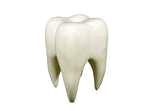Stomatology and dental health
|
|
Sparkle your smileMost people know that the teeth are the hardest and strongest part of the body. There's more than meets the eye, though. Teeth are actually a living part of your body that has blood vessels and nerves. If you used to judge your teeth like a book by its cover, then you're in for one big surprise. Teeth anatomy is a lot more complicated than you ever thought. Excellent crowns and bridges were made by the Etruscans in the 7th cent. B.C. At about that time, teeth were being extracted in Asia Minor as a cure for bodily ills and diseases. Skills achieved by the Etruscans, Phoenicians, Egyptians, Greeks, and Romans were largely lost during the Middle Ages, when barbers and roving bands of charlatans practiced unskilled dentistry at marketplaces and fairs. Abulcasis, a Spanish Moor, was one of the few in his time who studied dental surgery. The permanent teeth are the second set of teeth that will last the rest of your life. They tend to be more yellow (and not just because of coffee) and are extremely hard. The final set of teeth is made up of 32 teeth, or 16 on each jaw. There are two central incisors for biting, two lateral incisors for biting, two canines for tearing and cutting, four premolars for chewing, and six molars for chewing. What are dental implants?Tooth loss is something no one looks forward to. If you lose one or more teeth, you have a number of options, one of which is dental implants. You owe it to yourself to be informed as possible about these options. With this in mind, we've created this section on dental implants. Begin learning more about dental implants for tooth replacement exacltly now! Implants are surgically placed in your jaw bone while under anesthesia. It is a very time consuming procedure when having many implants placed. As this procedure is surgical, it is very important to research and find a well credited cosmetic dentist that you are comfortable with. For some people there are varying degrees discomfort or pain, which subsides in a couple of days. As with similar types of surgery, bruising and minor swelling might also develop shortly after the procedure. If you're missing one tooth or all of your teeth, implants may well be for you. So long as you have enough bone in the area of the missing tooth to facilitate the anchorage of the implants, this procedure can yield terrific results. If you don't have enough bone for this purpose, a bone graft may be necessary. A procedure of building up the bone is known as Bone Grafting. Bone grafting is common with dental implants. The bone that is used is one of three types. The preferred bone to use is taken from other areas of your mouth or collected in a suction device as the drilling of the sites for dental implants occurs. Sometimes bone is taken from areas such as a hip (this requires an orthopedic surgeon and an operating room). The third source for needed bone is a synthetic type. This is the least preferred type of bone to be used for this procedure. Colored tooth fillingsAt some point or other in ours lives, most of us wind up with a cavity. In most cases, a cavity calls for your dentist to remove the decay and to fill in the tooth area that was removed. There have been a number of advances in the field over the past few years, so if you're one of the lucky ones and haven't had a cavity in a while, you should read up on what is available today so that you understand the choices available to you. Most of us have had amalgam fillings (silver) or gold filling restorations. Some amalgam fillings were what we have called mercury fillings, as some amalgam fillings contained mercury. Metal fillings were effective, but very conspicuous and tended to blacken in color over time. Composite resin dental fillings were created as an alternative to traditional metal dental fillings. Tooth fillings colored to look like a natural tooth are known as Composite Resin Dental Fillings,are made of a plastic dental resin. Composite Resin Dental Fillings are strong, durable, and make for a very natural looking smile. Many dental insurance plans cover their use. If over half of your molar tooth's biting surface is decayed an inlay or onlay may be a better option than a filling. These options are basically for when more than a filling is needed but less than a crown will do. An inlay is placed in between the cusps of the tooth, whereas an only will cover one or more of the cusps. They can be made of a gold alloy, porcelain or tooth-colored resin and are cemented into place. Tooth veneersVeneers provide a durable solution to the color and shape problems that are common to so many people. Veneers are applied to fronts or visible areas of the teeth. The enamel (outside layer of the tooth) is ground down or reduced by just fractions of a milimeter in order to allow for the thin (contact lense thickness) veneer to be permanently attached to the tooth. Dental veneers can be made from porcelain or from resin composite materials. Porcelain veneers resist stains better than resin veneers and better mimic the light reflecting properties of natural teeth. Resin veneers are thinner and require removal of less of the tooth surface before placement. You will need to discuss the best choice of veneer material for you with your dentist. Teeth enamel discoloration can be caused by staining, aging, or chemical damage to teeth. Some of the more common causes of teeth discoloration are medications, coffee, tea or cigarettes. People who drink significant amounts of cola soft drinks can experience similar staining. Tooth crown procedureBe sure to discuss with your cosmetic dentist that the cement color used for your permanent crown will be the same as used for your temporary crown. A try in paste is used for this purpose. The color of the cement does affect the overall color of a porcelain crown, so this needs to be discussed long before your temporary crown is placed. In some cases your cosmetic dentist may choose to use a Flipper instead of a temporary crown. A Flipper is a false tooth to temporarily take the place of a missing tooth before the permanent crown is placed. A Flipper can be attached via either a wire or a plastic piece that fits in the roof of your mouth. Flippers are meant to be a temporary solution while awaiting the permanent crown. There are basically three types of crowns, those made of gold, ceramic crowns and ceramic-veneered gold crowns. Gold and metal-ceramic crowns are extremely durable and are normally used in molars, where the forces from chewing and grinding are most prevalent. Ceramic crowns are used primarily for front teeth, since they can best resemble the natural tooth color.
Terms interpretingStomatology Tooth bleaching Find yourself a new love
|

